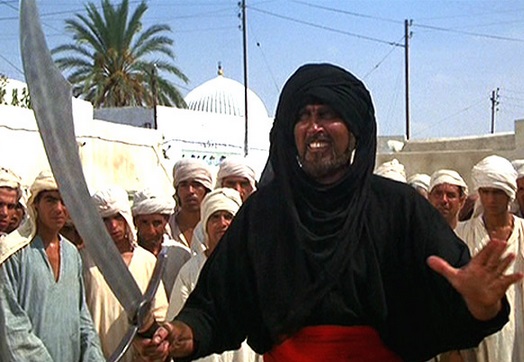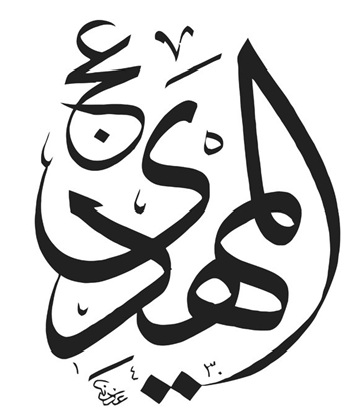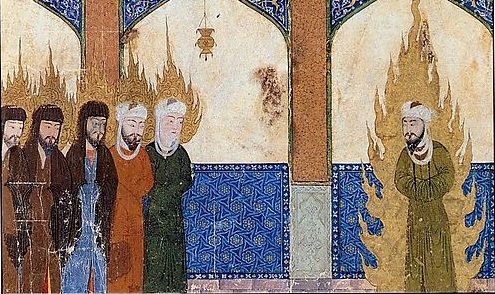  |
 |
 |
 |
|
MahdiWatch.org
|
 |
|
Home | About Me | Links to My Articles | Info on My Books | Contact Me
|
 |
|
Welcome to MahdiWatch.org! NEWSFLASH! COMMENTS LINK
BELOW EACH POST IS ENABLED! FEEL FREE TO BURY ME, PRAISE ME--OR JUST ISSUE A PERSONAL FATWA!
al-Mahdi is "the rightly-guided one" who, according to Islamic Hadiths (traditions),
will come before the end of time to make the entire world Muslim. Over the last 1400 years numerous claimants to the
mantle of the Mahdi have arisen in both Shi`i and Sunni circles. Modern belief in the coming of the Mahdi has
manifested most famously in the 1979 al-`Utaybi uprising of Sa`udi Arabia, and more recently in the ongoing
Mahdist movements (some violent) in Iraq, as well as in the frequently-expressed public prayers of former Iranian
President Ahmadinezhad bidding the Mahdi to return and, in the larger Sunni Islamic world, by claims that Usamah bin Ladin
might be the (occulted) Mahdi. Now in 2014 Mahdism is active in Syria, as the jihadist opposition group Jabhat al-Nusra
claims to be fighting to prepare the way for his coming; and in the new "Islamic State/caliphate" spanning
Syrian and Iraqi territory, as its leadership promotes the upcoming apocalyptic battle with the West at Dabiq, Syria. This site will track such Mahdi-related movements, aspirations, propaganda and beliefs in both Sunni and Shi`i
milieus, as well as other Muslim eschatological yearnings.
For a primer
on Mahdism, see my 2005 article, "What's Worse than Violent Jihadists?," at the History News Network: http://hnn.us/articles/13146.html; for more in-depth info, see the links here to my other writings, including my book on Mahdism.
|
|
|
|
Saturday, February 23, 2013
The Mahdi--Stuck Outside the Cloud?
3:57 pm est
Tuesday, February 19, 2013
The Mahdi v. the Wahhabis-Salafis: the Haqqani Battle of Evermore
Frequently on this blog I analyze the
historical and theological connections between Sufism (Islamic mysticism) and Mahdism; often, I discuss
the antagonism between Sufism and Salafism/Wahhabism (Islamic fundamentalism, for readers from Rio Linda, the State Department
or CIA). But I have never theorized that Sufi-based Mahdism might be, at least in part, a reaction to Salafism—this
intriguing proposition comes courtesy of Dr. Itzchak Weismann at the University of Haifa (Israel) via a paper entitled “The
Myth of Perpetual Departure: Sufis in a New (Age) Global (Dis)Order,” which he was kind enough to let me read ahead
of its upcoming publication in Itzchak Weismann, Mark Sedgwick and Ulrika Martensson, eds., Islamic Myths and Memories:
Mediators of Globalization (Farnham, Surrey, UK: Ashgate, forthcoming).

His paper deals with the Haqqaniyya branch of the Naqsbhandiyya Sufi
order, whose “teachings combine the rejection of Western civilization, nostalgia for the lost Ottoman caliphate and
unbridled animosity to the Islamic fundamentalist trend with the the cultivation of Western discipleship, interest in New
Age culture and a belief in the imminent appearance of the awaited one—the Mahdi” [emphasis added].
The Haqqani founder, Muhammad Nazim `Adil al-Haqqani, was born in 1922 in Turkish Cyprus and claims familial connections
with both the Qadiriyya and Mevleviyya (“Whiring Dervishes”) orders. His early education was
a blend of tradition Islamic religious studies and secular science—a degree in chemical engineering from Istanbul University—while
later he became a Sufi adept and started his own branch of the Naqsbhandiyya. Shaykh al-Haqqani is a firm
believer in using the latest media to advance his particular Islamic message, and is unique even in Sufi
circles for his frequent and vituperous condemnations of Salafism/Wahhabism as not just “the archenemy of Sufism”
but “a disgrace to the Muslims, and the cause for the militant image that is now associated with Islam in the West”—to
which he links his particular (and rather fluid) “apocalyptic vision.” Shaykh
al-Haqqani’s son-in-law and “deputy” in the Western Hemisphere is Hisham Kabbani (born in Lebanon, 1945)
who also was trained in both Islam and science (chemistry degree). He has founded a number of Sufi centers
in the US and, like his mentor, rails against Islamic fundamentalists while appealing to non-Muslim Westerners under rather
New Age auspices disseminated via the Internet—including aspects of Shaykh Nazim’s Mahdist prognostications. Dr. Weismann notes that Nazim al-Haqqani’s eschatological warnings are rooted in the same
Islamic angst that arose, in modern times, with the Six Day War of 1967 and were further ramped up by the “Mahdist”
occupation of Mecca’s Grand Mosque in 1979. (I explored the effects of both the
Six Day War, and the Juhayman al-Utaybi uprising, on Islamic eschatology in my 2001 doctoral dissertation, “Eschatology
as Politics, Eschatology as Theory: Modern Sunni Arab Mahdism in Historical Perspective,” pp. 1-52 and pp. 243-248)
but adds that al-Haqqani is, however, “unique among the Mahdists” in that he opposes Sunni fundamentalism.
And, unlike them (although Weismann never actually states this), al-Haqqani’s Mahdist views have changed over
the years. Almost a quarter-century ago, he wrote that the
Mahdi was “living in solitude in a cave in the Rub` al-Khali desert in Arabia”—reality imitating art?—but that they were in contact and the Mahdi would appear “soon,” following a US-USSR
nuclear war that would enable the Dajjal to conquer the whole world except for Mecca, Medina and Damascus (as per some hadiths),
whereupon Jesus, the Mahdi and their followers would defeat him (helped afterwards by radioactivity-soaking jinns!).
In later versions, his apocalyptic scenario replaced “godless” Western materialism and Communism as the
enemies of Islam with the Wahhabis-Salafis, so that by the early 1990s he was lecturing that Westerners would come to believe
in the Mahdi more than even Arab Muslims and that when the Mahdi came, he would behead Wahhabi scholars. A
few years on, as the Christian millennium approached, the Shaykh envisioned the USA in an even more favorable light, as
a global bringer of peace. Here in the early years of the 21st century, Shaykh Kabbani has taken
up the eschatological prognostication mantle while retaining its core anti-Wahhabi/Salafi element, according to Dr. Weismann—who
also maintains that the “underlying motivation behind” the Haqqani Sufi eschatological paradigm is “the
militant Islamist threat” and thus that this “apocalyptic myth…amounts to a call to the foremost Western
powers and especially the USA to join hands with the spiritual forces of Sufism in a common struggle against worldwide ‘Wahhabism’
and establish…a new(-age) global order.” In sum, Weismann sees the two Haqqani Sufi leaders
as reimagining Mircea Eliade’s “myth of eternal return” for the modern age of globalization—which has caused so much sturm und
drang for the Islamic umma in particular—primarily as a reaction to their co-religionist Wahhabi and Salafi
rivals: The Mahdi will come to vindicate the Sufis, devastate the Islamists, convert the
West and create (with a little help from his Muslim prophet friend, Jesus) a global Islamic state prior to the End of Time.

Muhammad preaching to Abraham, Jesus and some other unidentified prophets. The Mahdi will resemble
one of these--so don't say you won't be able to recognize him!
Observations:
1)
This Haqqani Sufi Mahdism is but the latest example of the historical Sufism-Mahdism nexus—but at least this one is
peaceful (so far), unlike many manifestations thereof: the 19th c. Sudanese Mahdi Muhammad Ahmad; the short-lived (literally)
Turkish Mahdi Mehmet, 1930; the al-Qahtani-al-Utaybi Mahdist revolt in Mecca, 1979. Note, however, that
while the Mahdi’s followers are to exhibit a pacific belief in him, the Mahdi himself will be quite ferocious once he
appears, particularly toward Wahhabis-Salafis.
2)
This is SUNNI Mahdism, for the Haqqaniyya tariqa (“order”) is a Sunni one—once again disproving
the persistent conventional wisdom that Mahdism is a Shi`i phenomenon.
3) Ironically, considering the Sufi-Salafi/Wahhabi acrimony, al-Haqqani engages in the same sort of
“newspaper exegesis” as do the latter—and which is almost certainly borrowed from American Protestant eschatologists
such as Hal Lindsey.
4) Along with deploying
Mahdism as an anti-Wahhabi/Salafi salient, the other major innovation of Shaykh Nazim is his using the belief as a hook to
attract Westerners to Islam via the latter’s attraction to “New Age”-style mysticism. (For
an example of how this may be working—albeit probably not in the way either Shaykh Nazim or Shaykh al-Kabbani intended—see
this new rap song and video by The Underachievers, called “The Mahdi.” Lyrics such as “I’m…Soldier of the Father/But
ain’t no Christian” might be edifying to the Sufis, but the incessant usage of the “n-“word
appears rather novel in Mahdist discourse.)
5) Does
expressing the hope that the Mahdi will come and decapitate Wahhabi scholars indicate that Shaykh Nazim al-Haqqani feels the
Sufis are losing the global da`wa, and that the only recourse he sees is divine intervention? If
so, this Sufi Mahdism is profoundly morbid, not hopeful.
6) The worldwide leader of the Haqqani Sufi order is not afraid to blame fellow Muslims—Wahhabis and
Salafis—for the “militant image” of Islam regnant in the West (and, indeed, globally). One
may safely surmise he knows more about Islam than John Brennan, Eric Holder and even Barack Husayn Obama. Perhaps
the current US administration could learn something from Shaykh Nazim.
7) This Sufi Mahdism is eerily similar to the Twelver Shi`i brand espoused from Qom and Tehran, mutatis
mutandis. In particular, both expect that when the Mahdi/Twelfth Imam (re)appears, he will humble
(to put it mildly) the Sunni fundamentalists. Is a de facto Sufi-Shi`i alliance over against the
Wahhabi-Salafi-AQN front out of the question, then? Perhaps Ahmadinejad should have traveled to Cyprus
to meet the Haqqani shaykh, rather than to Egypt to shake hands with the Muslim Brotherhood President Morsi.
8) Ultimately, while Dr. Weismann presents substantial
and compelling evidence that the Haqqaniyya order’s leadership is utilizing Mahdism as both a shield and sword
against Sunni fundamentalists, I remain, at this juncture, “almost persuaded” that such has been conclusively
proved. But certainly this brilliant paper/chapter reminds those of us who follow Mahdism to look
for similar trends in other Sufi orders across the globe. According to the enormous Pew study from 2012,
“The World’s Muslims: Unity and Diversity,” belief in the imminent coming of the Mahdi (and Jesus) is rampant in the Islamic world
(as I examined in this article, four in ten Muslims expect the Mahdi in their lifetime). Mahdism,
whatever milieux whence it springs, remains a powerful Islamic doctrine, as it has been for at least a millennium.
And with superb studies like Dr. Weismann’s available, no one will be able to say that they were not apprised
of Mahdism’s potential—for good or evil.
[For any readers who don't know, "The Battle of Evermore" is a Led Zeppelin song about an apocalyptic battle which draws heavily upon the imagery of Tolkien. I have linked
to the post-Zeppelin performace by Jimmy Page, Robert Plant and a bevy of North African musicians.]
|
|
|
|
| Jamkaran Mosque near Qom, Iran (during my trip there Aug. 2008) |
|
|
|
